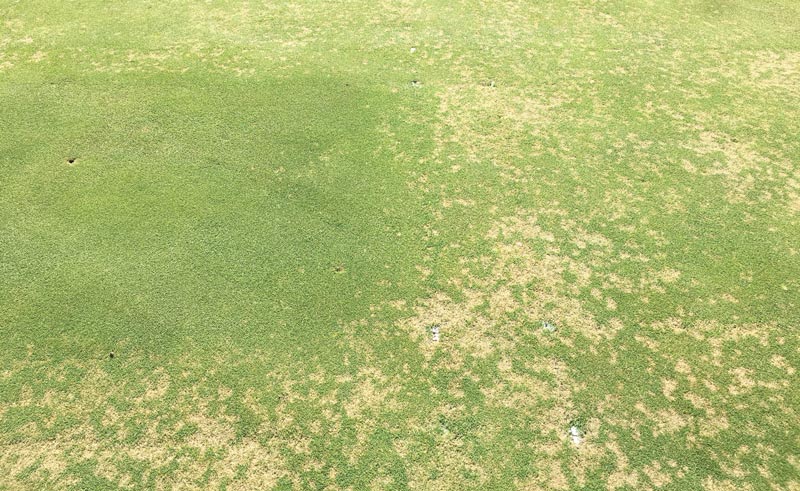
Photo by Ron Townsend
Dollar spot is the most economically important disease of golf course turfgrass in North America. Previous research has shown that nitrogen fertilization may reduce dollar spot severity, but the results have been mixed, and the impact of nitrogen on the dollar spot pathogen’s production of the virulence factor oxalic acid is unclear.
The objectives of this study were to evaluate the impact of nitrogen fertilization on dollar spot severity in the field, and to determine how oxalic acid production is influenced by nitrogen and ambient pH in vitro.
A three-year field trial was initiated in spring 2015 to test the impact of four different nitrogen rates (4.35, 8.70, 17.32 or 26.13 pounds nitrogen/acre [4.88, 9.76, 19.42 or 29.29 kilograms/hectare]) on Penncross creeping bentgrass maintained at putting green height at locations in Madison, Wis., and Glenview, Ill. The in vitro assays measured oxalic acid production and pH change of two S. homoeocarpa isolates grown in potato dextrose broth (PDB) media.
Results from the field trial indicated that, at the highest nitrogen rate of 26.13 pounds/acre, dollar spot suppression was comparable to that of a fungicide program, while the lower nitrogen rates were comparable to the non-treated control. In vitro results demonstrated that the fungus produced more oxalic acid when initial PDB pH was 7 compared with an initial pH of 4.
This research demonstrates that nitrogen fertilization alone can provide effective dollar spot suppression and that the fungus may produce oxalic acid to create a more favorable pH for fungal infection. Future techniques altering the production of oxalic acid through nitrogen fertilization and other cultural practices may lead to novel management strategies for this important disease.
— Ron V. Townsend and Paul L. Koch, Ph.D., University of Wisconsin-Madison, Madison, Wis.; and Edward J. Nangle, Ph.D., Ohio State University Agricultural Technical Institute, Wooster, Ohio
Editor’s note: An earlier version of this summary was published in the 2017 ASA-CSSA-SSSA Meeting Abstracts, ASA, CSSA and SSSA, Madison, Wis.
Teresa Carson is GCM’s science editor.